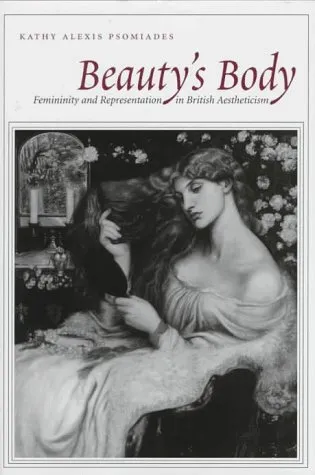Beauty’s Body: Femininity and Representation in British Aestheticism
By (author): "Kathy Psomiades"
ISBN0804727848
ISBN139780804727846
AsinBeauty’s Body: Femininity and Representation in British Aestheticism
Original titleBeauty's Body: Femininity and Representation in British Aestheticism
Beauty's Body is about how Art comes to wear a feminine face in the painting, poetry, and prose of British aestheticism, and what it means that it wears that face—for art, for women, and for those who, a century later, construct theories about aesthetics and gender.The book argues that representations of femininity in aestheticist writing and works of art are not merely incidental or decorative, but play an integral part in the cultural work of aestheticism. Aestheticism's feminine figures help construct the category of "the aesthetic" and the concept of self-reflective, autonomous art that goes along with it. Visually appealing and yet inaccessible, feminine figures also provide for a new kind of relation to objects that makes possible advanced commodity culture. By looking at how femininity functions as a system of signification in Victorian aestheticism, moreover, we can see the ways in which much of our own theorizing about aesthetics unconsciously employs a similar system of signification to manage, through disavowal and evasion, its own internal contradictions.The book moves from the Pre-Raphaelite poetry of Christina Rossetti, Dante Gabriel Rossetti, and Algernon Charles Swinburne, to the paintings of Rossetti, James Whistler, and Edward Burne-Jones, to the drawing rooms of art collectors and the people of taste imagined by aestheticist experts like Charles Eastlake, to the anti-aestheticist parodies that appear in George Du Maurier's Punch cartoons and Vernon Lee’s satirical Miss Brown. It places Mary Elizabeth Haweiss’s beauty manuals alongside the praises of cosmetics in the work of "decadent" writers like Aubrey Beardsley and Max Beerbohm.In the process, the book maps out the ways in which the sign of femininity functions to hold aestheticism together and manage the contradictions inherent in the claim to artistic autonomy in commodity culture. Finally, Beauty's Body argues that aestheticist texts provide the critical tools for examining moments in the work of twentieth-century Marxist theorists of the aesthetic—Peter Bürger, Herbert Marcuse, Theodore Adorno—moments in which femininity functions as the limit of theory, aestheticizing the ideas or phenomena it touches and thus removing them from the realm of things that have to be accounted for or explained.
